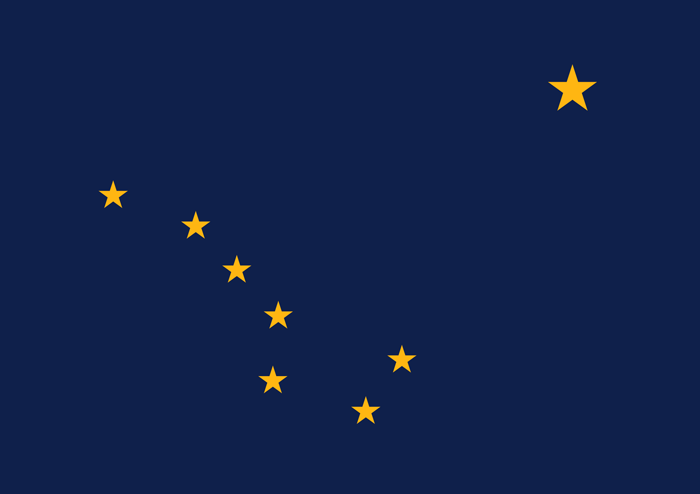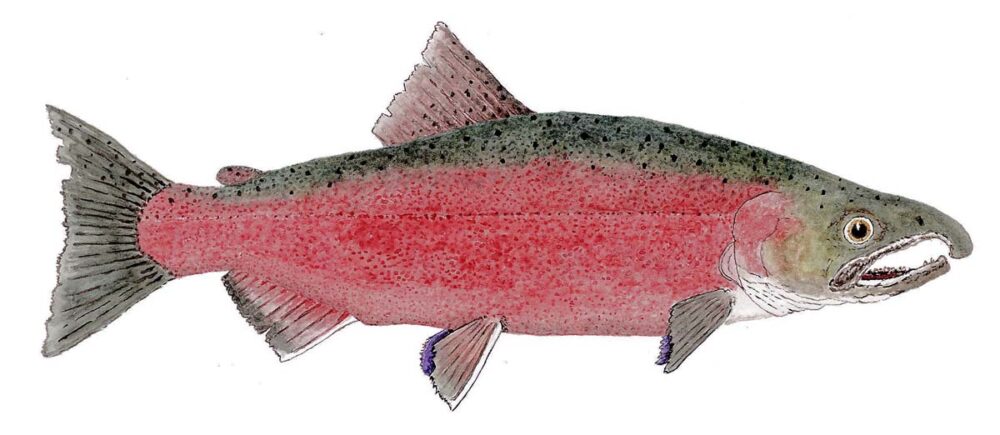
Male coho salmon spawning colors. Illustration by award winning watercolorist Thom Glace.

Coho [Silver] Salmon Fresh ocean run colors. Thom Glace . . .
By Skip Clement with illustrations by Thom Glace
My long-time fishing buddy from Allentown, Pennsylvania, Jim Brooke, called me at my office in Pittsburgh on a Thursday afternoon in late fall. Jim said he found a deal on an Alaskan fishing trip: one week for only $3,000. Standard “lodge” fees were $5,000 to $10,000 per week, per person.
I asked what’s the catch
We had to leave tomorrow, Friday, and be flyout-ready a few miles from Anchorage on Saturday. Alaska for $1,500 was too good to turn down. My wife’s objections were Richter scale rated by our local newspaper. The story appeared above the fold next to the blueberry pie recipe of the week.
Brooke was as irresponsible as I was when it came to taking a destination fishing trip
Jim described the Alaska destination as being in its first year of operation. It was a wild, virgin country with big rainbows, dollies, and silver salmon in the fall. Jim said: “It would be luxury tents, gourmet food, and skilled guides.”
On the following morning, in early September, I boarded a plane from Pittsburgh to Seattle and then to Anchorage to catch up with Jim for a genuinely forgettable hotel dinner.
Saturday
After a short taxi ride to the dock, we flew on a De Havilland float plane to the Alagnak River. The flight was spectacular. Coming from urban sprawl and a flat landscape to a clear-sky Alaskan day was a treat. As far as you could see, wilderness—rivers, lakes, mountain ranges, grizzly bears, foxes, wolves, bald eagles, and salmons. No trace of human interaction with Mother Nature is detectable. It’s hard to ignore how that can be invigorating it was.
Anyway, there’s an oxymoron at work here that some may have already picked up on. There’s no such thing as a “luxury tent.” Even dyed-in-the-wool campers will vouch for that. Our arrival at the “lodge” revealed a wild place but shoddily kept grounds. The greeters, lodge owner, and chef were the enormously overweight, cigarette-puffing, shirt-stained early work release types. They seemed to have a grudge against humanity. We couldn’t wait to see our “luxury” tent.
The smell of mildew was the first sign of something not right
There was no heater, and the army-style cots [29 ‘wide X 72″] were wet, as were the camp-provided sleeping bags folded at the foot of the two rickety cots. We put the cots outside, turned our sleeping bags inside out, and draped them over the tent in the sun—a gentle breeze would dry everything out and keep us mosquito-free for the day.
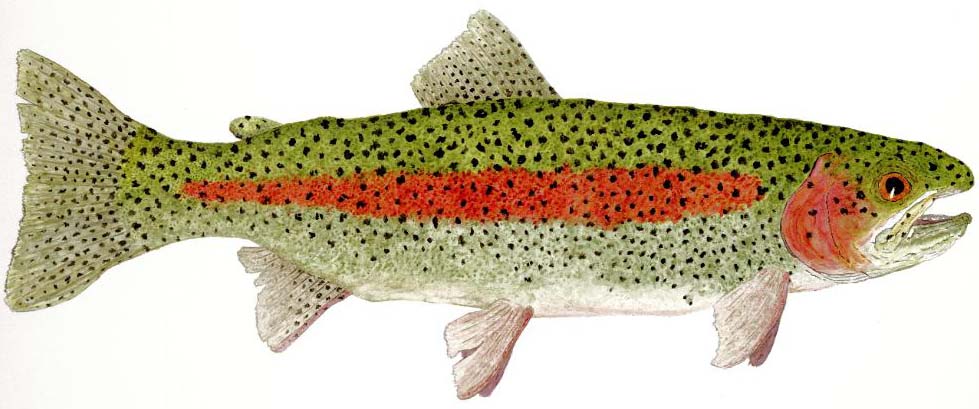
Rainbow trout by Thom Glace.
Grumpy, whom we named the owner, took us out fishing after lunch, which had been a lousy boloney sandwich on Wonder Bread with mustard – washed down with sugar-rich Kool-Aid. Just west of the camp, the fishery was outstanding from the get-go. Jim, a spin guy, hooked up within minutes of our parking on a sandbar with a green-looking silver in the 10-pound range and me soon after on a 7-weight with a rainbow of about 5-pounds. We each caught and released about a half dozen silvers, rainbows, and dollies for the next two hours.
The attitude of the bright silvers was predictable, and the reason we came
They are as aggressive as Spanish mackerel, fight hard, and always go airborne during any hook-up. Given the confines, landing a 13-pound silver on a seven was a little struggle. Reluctantly, I wore out the fish – a nine would be my weapon for the rest of our stay.
Targeting silvers, I used a floating line with a 9-weight. The leader butt was 7-feet of 50-pound with a 2MM tippet ring [25-pound], then IGFA tippet of 20-pound
Most of my flies were many variations of Blessings’ Woolly Bugger – from brightly colored to black and all with a hint of flash. Mice and leeches had their box, as did orange egg patterns. The mouse (voles) patterns popped in the water from a river’s edge/land/brush.
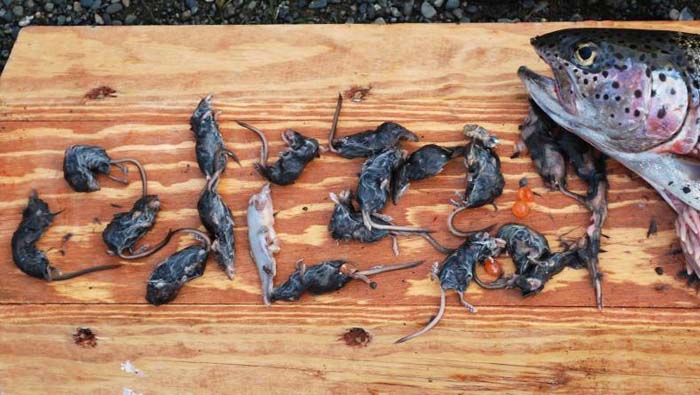
This Alaskan rainbow trout devoured 19 shrews (moles, voles, and shrews) before it was caught. (Facebook/Togiak National Wildlife Refuge). Story by Gabrielle Levy, UPI.com.
We caught some bows while ‘mousing’ – giant, double-digit animals
The week of fishing was terrific, even on windless days when uninvited mosquitoes gorged on us. The guide we were assigned was nearly useless; he knew nothing about boat captaining, fishing, Alaska, or the outdoors. He was the owner’s brother-in-law and was far more interested in provoking a bear into engagement so he could shoot it with his pearl-handled 45. He bored us to tears with his tales of “shooting” things. We guessed his IQ at about 67.
Throughout the week, the food remained consistent with our first lunch. The toilet and showering facilities were unfit for prisoners of war. The nights were almost sleepless, and we always woke up wet. The tent would sweat from the heat we threw off. Thank God the vodka supply held up.
NOTE: The “lodge” made it into the second season and then folded.
About the Alagnak River:
The Alagnak begins as the outflow of Kukaklek Lake in Katmai National Park and Preserve and meets the sea at Bristol Bay. The beginning of the river lies in the Aleutian Range. The first six miles of the river run slowly through the tundra. Vegetation along the upper part of the river consists mainly of spruce. Afterward, the valley becomes much narrower with near-vertical rock faces. Miles 7-14 run through a narrow canyon at around 7.5 mph. The Nonvianuk River runs into the Alagnak at around mile 20. To the west, the river meanders over the Alaska Peninsula before flowing into the Kvichak River, which flows into Bristol Bay.
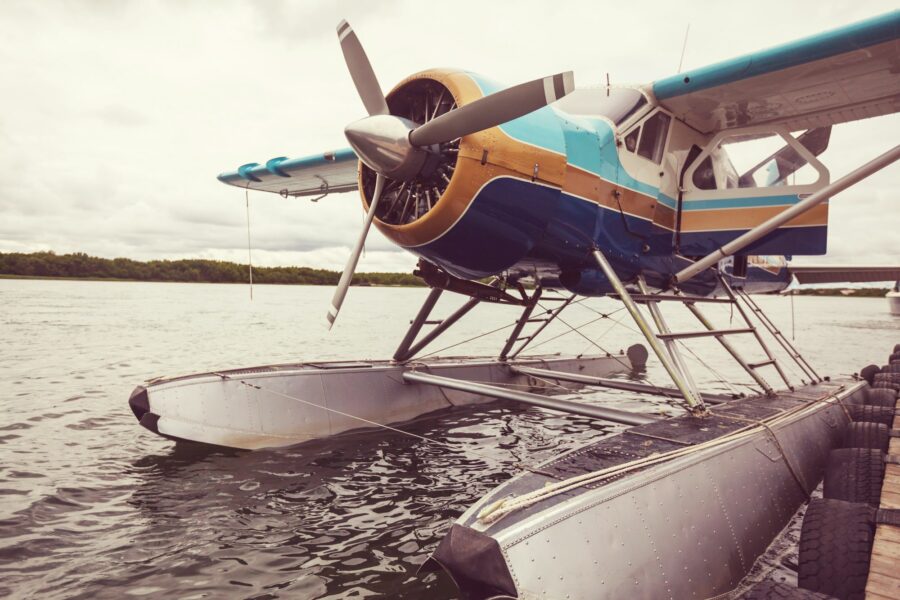
Small aircraft / Envato commons image


